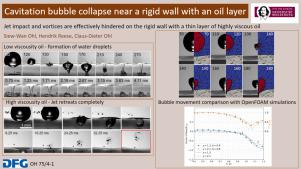当前位置:
X-MOL 学术
›
Int. J. Multiphase Flow
›
论文详情
Our official English website, www.x-mol.net, welcomes your feedback! (Note: you will need to create a separate account there.)
Cavitation bubble collapse near a rigid wall with an oil layer
International Journal of Multiphase Flow ( IF 3.8 ) Pub Date : 2024-02-08 , DOI: 10.1016/j.ijmultiphaseflow.2024.104761 Siew-Wan Ohl , Hendrik Reese , Claus-Dieter Ohl
International Journal of Multiphase Flow ( IF 3.8 ) Pub Date : 2024-02-08 , DOI: 10.1016/j.ijmultiphaseflow.2024.104761 Siew-Wan Ohl , Hendrik Reese , Claus-Dieter Ohl

|
This paper reports on the study of a laser-generated cavitation bubble in water collapsing near a rigid wall that is covered with a layer of silicone oil. The oil viscosity is between 5 and 5000 cSt. It is known that a collapsing cavitation bubble near a rigid boundary develops a jet. In this study, we show that the viscous oil layer competes with the flow generated by the bubble, and affects the short- and long-term bubble dynamics. For very low viscosity silicone oil (5, 10 and 20 cSt) the vortices formed when the water jet hits the wall result in a gas–water mixture in the oil layer. With increasing viscosity, i.e. 50 and 100 cSt, the formation of water droplets with gas bubbles inside the oil layer is observed. The bubble dynamics and flow in the oil layer are nicely reproduced with VoF simulations up to the second bubble collapse. In higher viscosity silicone oils (350, 500 and 1000 cSt), the water jet typically retracts completely during the re-expansion of the bubble. When a very high viscosity oil (5000 cSt) is used, a ‘mushroom’-shaped bubble is formed in water which splits in two as it collapses. To separate the regimes, we introduce a non-dimensional stress ratio relating the inertia and viscosity. This inverse Reynolds number becomes approximately 1 in the jet retraction regime. When 1.0, the jet impact and vortices are effectively hindered on the rigid wall.
中文翻译:

空化气泡在具有油层的刚性壁附近破裂
本文报道了对水中激光产生的空化气泡在覆盖有一层硅油的刚性壁附近塌陷的研究。油粘度在 5 至 5000 cSt 之间。众所周知,靠近刚性边界的溃缩空化气泡会产生射流。在这项研究中,我们表明粘性油层与气泡产生的流动竞争,并影响短期和长期的气泡动力学。对于粘度极低的硅油(5、10 和 20 cSt),水射流撞击壁时形成的涡流会在油层中形成气水混合物。随着粘度增加,即 50 和 100 cSt,可以观察到油层内形成带有气泡的水滴。通过 VoF 模拟,可以很好地再现油层中的气泡动力学和流动,直至第二次气泡破裂。在较高粘度的硅油(350、500 和 1000 cSt)中,水射流通常在气泡重新膨胀期间完全缩回。当使用粘度非常高的油(5000 cSt)时,水中会形成“蘑菇”形气泡,并在破裂时分裂成两半。为了区分这些状态,我们引入了与惯性和粘度相关的无量纲应力比。在射流回缩状态下,该倒雷诺数变为大约 1。当为 1.0 时,射流冲击和涡流在刚性壁上受到有效阻碍。
更新日期:2024-02-08
中文翻译:

空化气泡在具有油层的刚性壁附近破裂
本文报道了对水中激光产生的空化气泡在覆盖有一层硅油的刚性壁附近塌陷的研究。油粘度在 5 至 5000 cSt 之间。众所周知,靠近刚性边界的溃缩空化气泡会产生射流。在这项研究中,我们表明粘性油层与气泡产生的流动竞争,并影响短期和长期的气泡动力学。对于粘度极低的硅油(5、10 和 20 cSt),水射流撞击壁时形成的涡流会在油层中形成气水混合物。随着粘度增加,即 50 和 100 cSt,可以观察到油层内形成带有气泡的水滴。通过 VoF 模拟,可以很好地再现油层中的气泡动力学和流动,直至第二次气泡破裂。在较高粘度的硅油(350、500 和 1000 cSt)中,水射流通常在气泡重新膨胀期间完全缩回。当使用粘度非常高的油(5000 cSt)时,水中会形成“蘑菇”形气泡,并在破裂时分裂成两半。为了区分这些状态,我们引入了与惯性和粘度相关的无量纲应力比。在射流回缩状态下,该倒雷诺数变为大约 1。当为 1.0 时,射流冲击和涡流在刚性壁上受到有效阻碍。



























 京公网安备 11010802027423号
京公网安备 11010802027423号